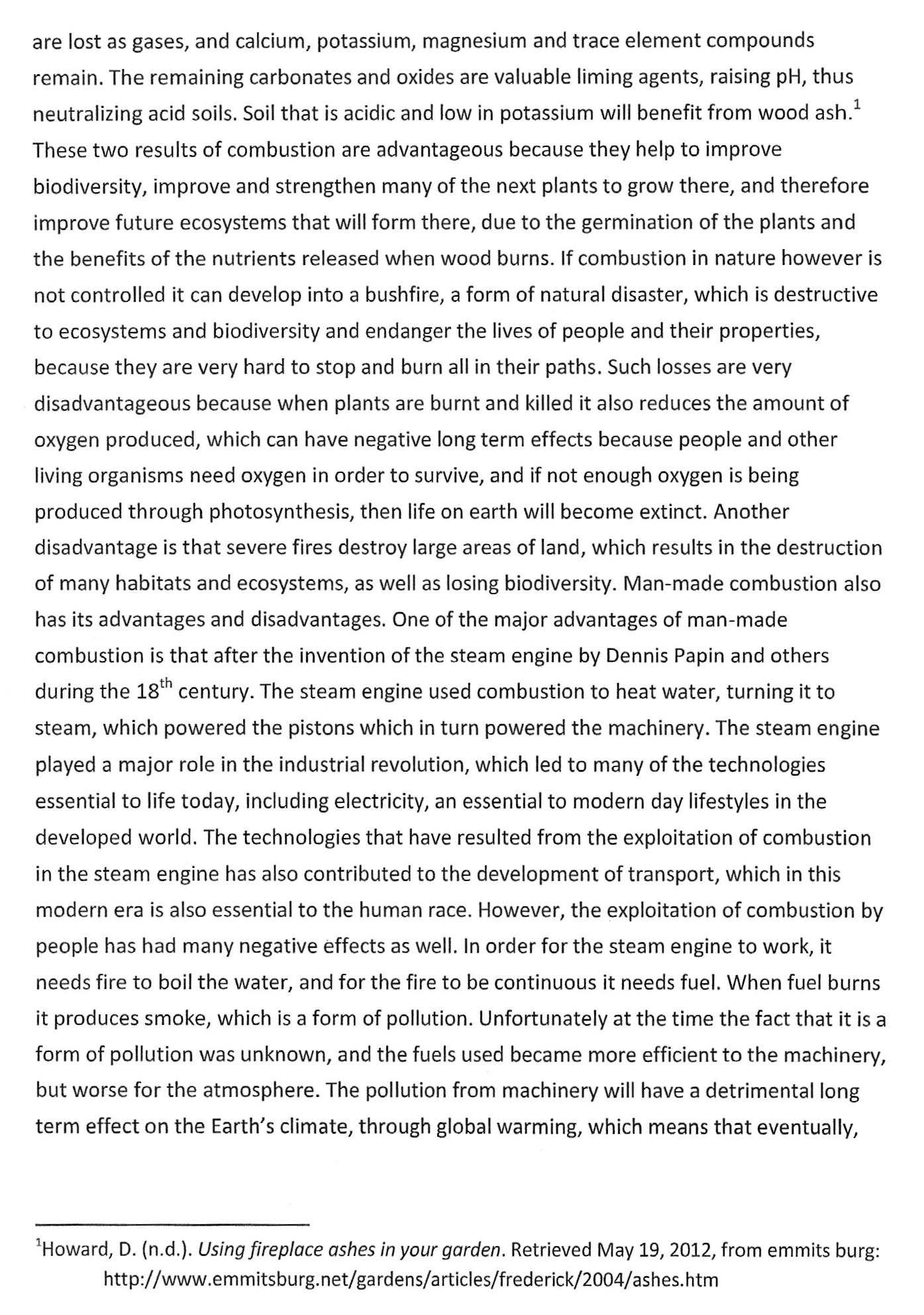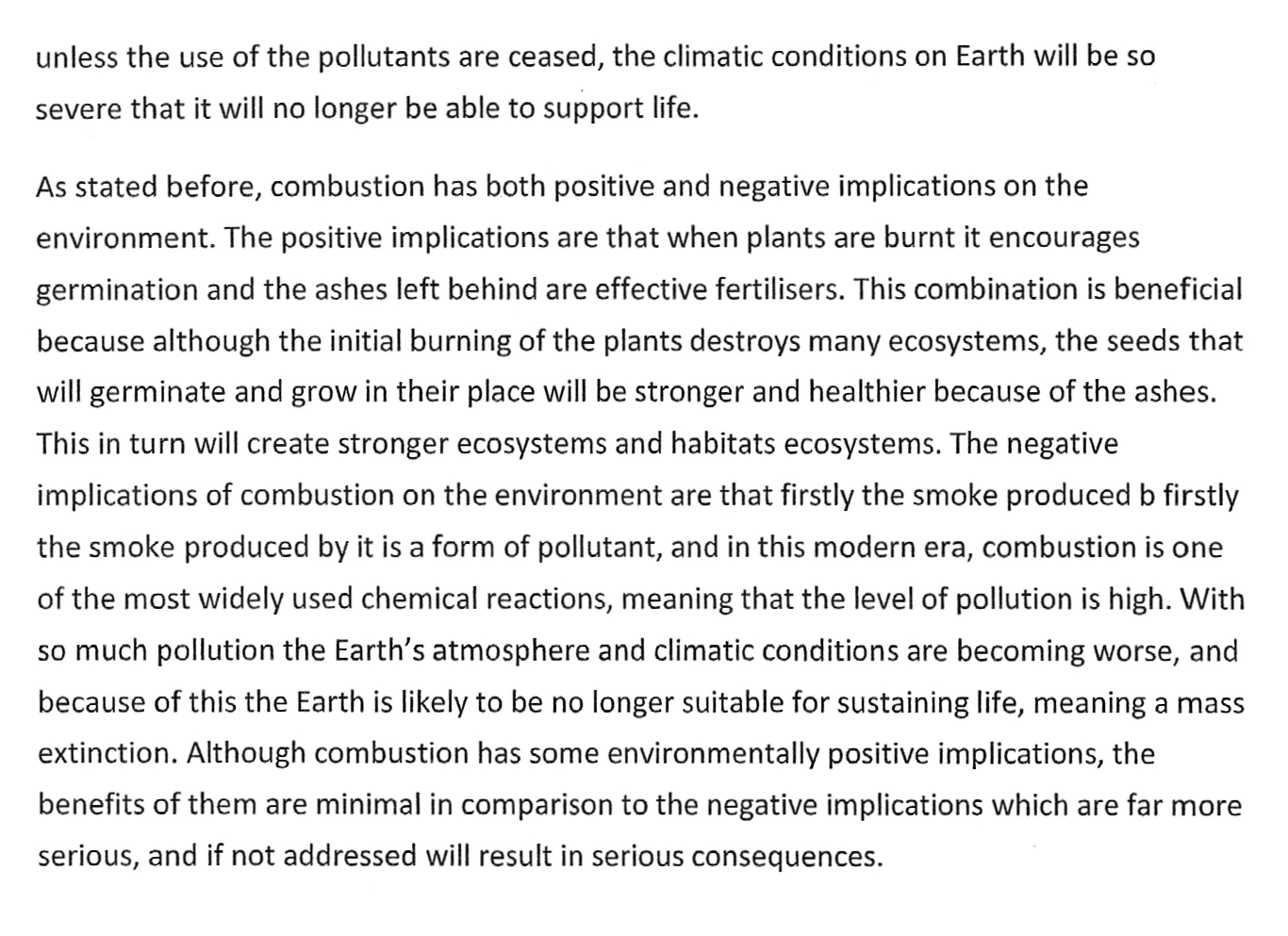- Home
- Resources
- Work samples
- Samples
- Chemical change – ABOVE
Science
Year 9
Above satisfactory
Chemical change
 1
Annotation 1
1
Annotation 1
Defines chemical change as formation of new substance involving breaking and re-forming bonds between atoms. Location of numbers on page matches annotation 2 Annotation 2
Explains energy transfer and transformation in exothermic and endothermic reactions 3 Annotation 3
Explains difference between physical and chemical change in terms of states of matter and molecular compositions of substances involved 4 Annotation 4
Describes in detail examples of chemical reactions that are important for society 5 Annotation 5
Classifies chemical reaction as endothermic and explains reason for classification
-
Annotations
-
1
Annotation 1
Defines chemical change as formation of new substance involving breaking and re-forming bonds between atoms. Location of numbers on page matches annotation -
2
Annotation 2
Explains energy transfer and transformation in exothermic and endothermic reactions -
3
Annotation 3
Explains difference between physical and chemical change in terms of states of matter and molecular compositions of substances involved -
4
Annotation 4
Describes in detail examples of chemical reactions that are important for society -
5
Annotation 5
Classifies chemical reaction as endothermic and explains reason for classification
 1
Annotation 1
1
Annotation 1
Applies understanding of chemical reactions to discuss in detail positive and negative social and economic implications of an industrial process 2 Annotation 2
Uses footnote to acknowledge source of information
-
Annotations
-
1
Annotation 1
Applies understanding of chemical reactions to discuss in detail positive and negative social and economic implications of an industrial process -
2
Annotation 2
Uses footnote to acknowledge source of information
Satisfactory
Chemical change
 1
Annotation 1
1
Annotation 1
Explains difference between chemical and physical change in terms of number and composition of substances involved 2 Annotation 2
Classifies reactions as natural and man-made and gives examples of each 3 Annotation 3
Identifies combustion as an exothermic reaction and explains what this means
-
Annotations
-
1
Annotation 1
Explains difference between chemical and physical change in terms of number and composition of substances involved -
2
Annotation 2
Classifies reactions as natural and man-made and gives examples of each -
3
Annotation 3
Identifies combustion as an exothermic reaction and explains what this means
 1
Annotation 1
1
Annotation 1
Applies understanding of chemical reactions to discuss in detail positive and negative social and economic implications of natural and man-made combustion reactions 2 Annotation 2
Uses footnote to acknowledge source of information 3 Annotation 3
Discusses role of combustion in technological development
-
Annotations
-
1
Annotation 1
Applies understanding of chemical reactions to discuss in detail positive and negative social and economic implications of natural and man-made combustion reactions -
2
Annotation 2
Uses footnote to acknowledge source of information -
3
Annotation 3
Discusses role of combustion in technological development
 1
Annotation 1
1
Annotation 1
Discusses positive and negative environmental implications of combustion
-
Annotations
-
1
Annotation 1
Discusses positive and negative environmental implications of combustion
Above satisfactory
Chemical change
 1
Annotation 1
1
Annotation 1
Defines chemical change as formation of new substance involving breaking and re-forming bonds between atoms. Location of numbers on page matches annotation 2 Annotation 2
Explains energy transfer and transformation in exothermic and endothermic reactions 3 Annotation 3
Explains difference between physical and chemical change in terms of states of matter and molecular compositions of substances involved 4 Annotation 4
Describes in detail examples of chemical reactions that are important for society 5 Annotation 5
Classifies chemical reaction as endothermic and explains reason for classification
-
Annotations
-
1
Annotation 1
Defines chemical change as formation of new substance involving breaking and re-forming bonds between atoms. Location of numbers on page matches annotation -
2
Annotation 2
Explains energy transfer and transformation in exothermic and endothermic reactions -
3
Annotation 3
Explains difference between physical and chemical change in terms of states of matter and molecular compositions of substances involved -
4
Annotation 4
Describes in detail examples of chemical reactions that are important for society -
5
Annotation 5
Classifies chemical reaction as endothermic and explains reason for classification
 1
Annotation 1
1
Annotation 1
Applies understanding of chemical reactions to discuss in detail positive and negative social and economic implications of an industrial process 2 Annotation 2
Uses footnote to acknowledge source of information
-
Annotations
-
1
Annotation 1
Applies understanding of chemical reactions to discuss in detail positive and negative social and economic implications of an industrial process -
2
Annotation 2
Uses footnote to acknowledge source of information